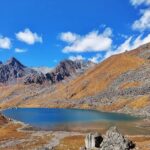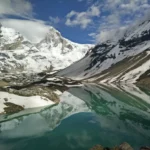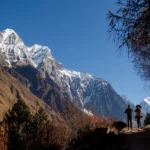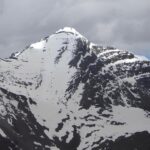Trekking in the outdoors is fun and fulfilling. Add the winter chill and the beauty of snow-capped mountains. Winter Trek can be a dreamy adventure in the wilderness. But if you are not well prepared for the mountains, the experience can turn unpleasant. When you are outdoors, two things to prioritize to enjoy to the fullest. Firstly, to keep yourself warm in freezing cold temperatures, and to keep yourself dry when the rain pours without any warning up in the mountains.
For outdoor enthusiasts, there is nothing more irritating and frustrating than dealing with wet clothes while climbing. This is also something that first-time trekkers should be wary of. Climbing in wet clothes with wind blowing could prove detrimental in multiple ways.
There could be various reasons why you would end up walking in those soggy layers, right from sweating incessantly to having forgotten your rain cover while packing. You end up losing body heat which is needed to keep you warm. These two are intertwined and important to keep your body properly functioning.
“Maintain a balance between heat production and loss in the body”
Now, let us first understand in what ways our body produces and loses heat. This flow of heat will help us decide ways to keep ourselves dry and warm on a winter trek.
Heat Production –
- Humans produce heat through basic metabolic activities that involuntarily take place inside the body.
- The next source of body heat comes from muscular activities undertaken by the body.
- The human body shivers when it is chilly. Shivering is involuntary and generates heat through muscular twitching.
Heat Loss –
- Radiation – It is the movement of heat from the body to the surrounding environment. All bodies radiate heat. Since humans have a warmer bodies than the surrounding area, we tend to lose heat when outdoors. Maximum heat loss occurs through our hands and head as the blood vessels are closer to the skin.
- Convection – It is the heat loss that occurs when a moving medium like wind or water sweeps away the heat produced from an exposed part of the human body. Eg – You lose heat when you stand in a cold breeze or cold stream of water.
- Conduction – It is the direct transfer of heat from the warmer to the colder object through physical interaction. E.g. – Sitting on a cold rock while trekking will result in loss of heat from your buttocks to the cold rock.
- Evaporation – It is the process of changing liquid into vapor. It requires heat for this transformation, so evaporating sweat cools your body down. Eg – A wet bandana on your head feels good on a hot day.
Now, you are aware of how heat is produced and lost through our body. These are important factors to determine our body’s layering, food, and water intake. Not just knowledge, but it takes self-discipline to keep yourself warm and dry in the outdoors.
There are three crucial aspects to regulating our body temperature on a winter trek:
- Balanced nutrition
- Hydration
- Layering
Let us start by explaining the food and water intake to regulate your body’s metabolism for proper functioning and heat production.
1. Balanced Nutrition –
- Eating a balanced diet of carbohydrates and fat keeps you warm on a trek.
- Having a heavy breakfast is critical to maintaining energy for a long day of the trek.
- Eating fats during dinner gives fuel early in the morning when carbs get metabolized.
- In harsh conditions, eating snacks day and night is a proven plan to stay warm.
2. Hydration –
- This helps utilize food more efficiently and hence generates more warmth.
- Helps to metabolize food and turn it into energy.
- This helps with better blood circulation.
- Drink 5-6 litres in the cold or at high altitude as cold temperature increases your urine output and hence dehydration.
- Your urine should always show signs of 3 Cs – Clear, Continuous, and Copious.
3. Layering –
The key to enjoying the wilderness even in harsh weather conditions on a winter trek is layering right. Layering plays a big role in keeping you warm on a cold chilly night. If layering is not done properly, you are susceptible to cold. To tackle the cold weather, it is recommended to carry a minimum of five layers of clothing. You can add a layer or two more if you are more prone to cold.
A Layered system with modern synthetic fibre is the best for keeping yourself warm and comfortable in any weather condition. This layered clothing creates dead air spaces which trap air and provide insulation if used properly. It is lightweight, functional, and breathable clothing.
As our upper body contains all the vital organs and is said to be the powerhouse of the body, if you keep your trunk warm, you will feel comfortable. That is why we will be talking about the upper body when we discuss layering.
There are 4 layers when you decide to follow the layering system:
1. Base Layer
- Your base layer should absorb moisture away from the skin before any evaporation takes place.
- Regulate body temperature.
- Evaporate faster and dry up quickly.
- Should cover and touch the entire upper body.
- A zip collar is used for venting.
- The base layer should be quick dry t-shirts. The base layer should be of polyester or nylon material that absorbs your sweat quickly.
- Cotton T-shirts or warmer as a base layer is a big no-no.
2. Mid Layer –
- The job is to continue that wicking process to get rid of moisture as sweat, but also insulation.
- Should prevent heat loss due to convection.
- Useful when you are active.
- This layer can vary from lightweight to heavy depending on where you are and the conditions.
- Should be breathable.
- The insulating or mid-layer can be a sweater, fleece jacket, – Breathable nylon wind cell, Lightweight fleece, and woollen shirt.
3. Outer Layer –
- To protect from the chilling effect.
- Comes into the picture when you are not active.
- Should be waterproof and windproof, breathable, and act as an insulator.
- Should be big enough to cover your base and mid-layer.
- Hood is mandatory to insulate your head as well.
- The outer layer comprises Down Jacket, or a padded jacket, and must be waterproof.
4. Rain Gear –
- Helps keep other layers dry. Since it is non-breathable, sweat gets accumulated inside if your body generates enough heat.
- Should have full sleeves and a hoodie.
- You should have the upper and lower part of this layer.
- Material includes – Full-length poncho with sleeves, and upper and lower nylon rain gear.
You can also refer to the practices mentioned below to keep yourself warm and dry on a winter trek.
- Change your clothes quickly as soon as you get wet.
- Avoid excessive sweating in cold weather.
- Watch out for the safety of others in cold, wet, or windy conditions.
And, some last tips to dry your clothes in absence of sunlight :
- Wear damp clothes over the polypropylene layer when you go inside your sleeping bag at night.
- Hanging wet socks & gloves over shoulders or inside the outer layer while working around the camp area.
- Sleep with damp gear underneath your abdomen.
- In extreme conditions, wet clothes can be dried near the fire with utmost care and precaution.
We hope this information will be helpful in understanding the importance of staying warm and dry in outdoors when you are trekking. Do share if you have any tips on staying dry and warm on a trek in the comments below.





